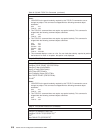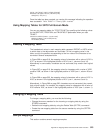
Summary of Mapping Tables
Table 61 shows the mapping tables associated with the AS/400 TCP/IP function and
identifies which command you use to specify these mapping tables.
Table 61. Summary Mapping Table Specification
AS/400 TCP/IP Function Mapping Tables Specified in
FTP client ASCII/EBCDIC FTP command
FTP server ASCII/EBCDIC CHGFTPA command
SMTP client ASCII/EBCDIC CHGSMTPA command
SMTP server ASCII/EBCDIC CHGSMTPA command
TELNET client 5250
full-screen mode
none
TELNET server 5250
full-screen mode
none
TELNET client 3270
full-screen mode
3270 table TELNET command
TELNET server 3270
full-screen mode
none
TELNET server line mode ASCII/EBCDIC can be used Handled in user program
TELNET client VTxxx
full-screen mode
ASCII/EBCDIC TELNET command
TELNET server VTxxx
full-screen mode
ASCII/EBCDIC CHGTELNA command or the
SETVTTBL command
Creating ASCII and EBCDIC Mapping Tables
Two tables are required for data processing in TELNET and FTP:
v One to map incoming data (user data and protocol information)
from
the remote
system character set and code page (ASCII-to-EBCDIC mapping)
v One to map outgoing data (user data and protocol information)
to
the remote
system character set and code page (EBCDIC-to-ASCII mapping).
You can use the mapping tables supplied with the system (see “EBCDIC and ASCII
Character Sets” on page 524) or create your own tables.
Note: For FTP, only the contents of the file are mapped; the file name is not
mapped.
To create a user-defined mapping table, you must do the following:
1. Use the Start Source Entry Utility (STRSEU) command to create a source
member containing the hexadecimal values you want included in the mapping
table. Each source member must contain 512 hexadecimal characters because
each mapping table contains 256 bytes of data.
2. Use the Create Table (CRTTBL) command to create the mapping table from the
source member.
3. Use the Grant Object Authority (GRTOBJAUT) command to grant user QTCP
*USE authority to the mapping table.
518 OS/400 TCP/IP Configuration and Reference V4R4


















